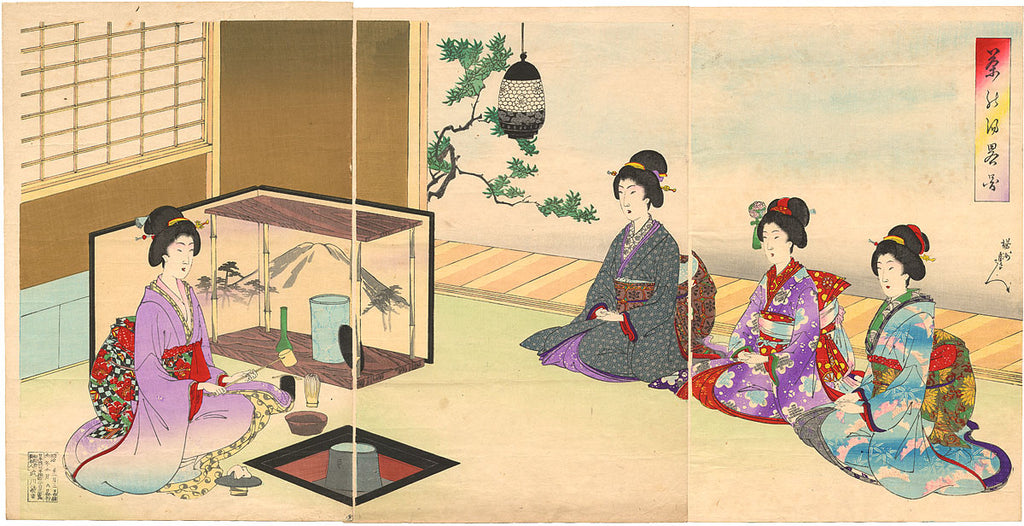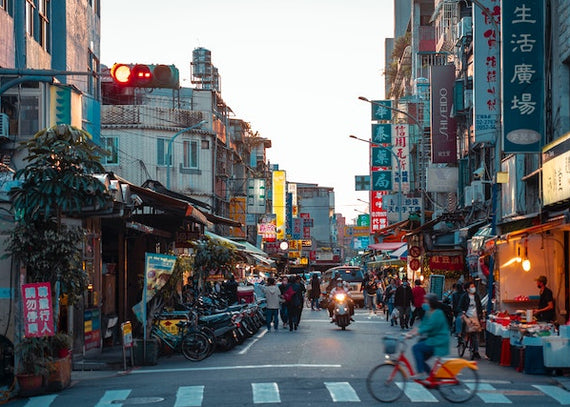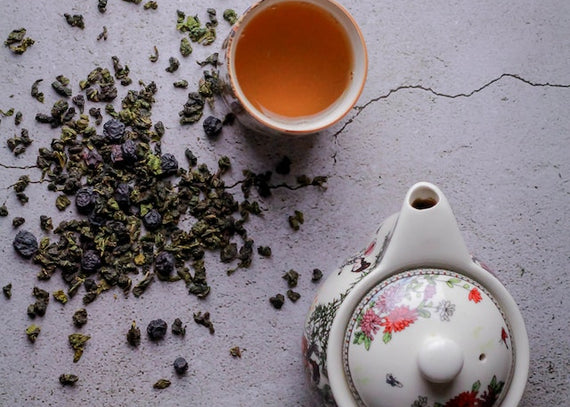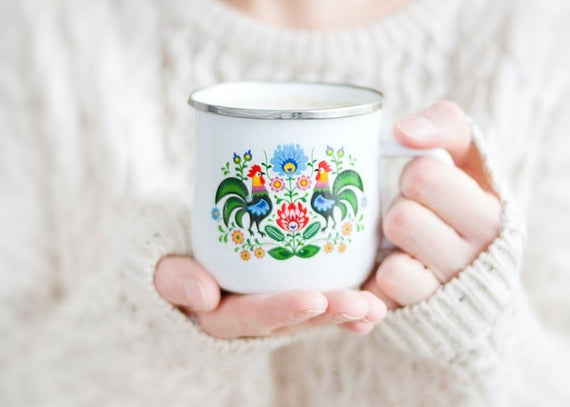Japan is the next most famous country for green tea after China. Japan is known, and rightly so, for matcha, the Tea ceremony and tea culture in general. Despite not being one of the "birth nations" of tea, Japan has adopted a robust and sophisticated tea market, mainly focused on green tea. Japanese teas are expertly cultivated and can be divided into several main classes. It should be noted that while matcha is famous in Japan, it was first developed in China and refers more to a means of processing than to a particular type of leaf, though matcha is produced from the tencha variety. The other kind of leaves and leaf infusions include sencha, fukamuschicha, kukicha, konacha, bancha, matcha, gyokuro, hojicha, and genmaicha. These tea distinctions not only depend on the type of leaves but how the leaves are processed and if the leaves are infused with other ingredients such as rice or other herbs. Two, in particular, include the sencha and gyokuro variations. Let us take a more intricate view of the world of Japanese Green tea.
History
The history of tea cultivation in Japan begins with the Buddhist monks Saicho and Kukai in the 9th century AD. It was during this time when Buddhism was flourishing in Japan and the rest of East Asia, and monks from Japan traveled to China to study the religion. The monks would return, not just with great wisdom, but also tea seeds and concepts of tea culture. Tea's association with both Buddhism as well as the ruling class in Japan can also be traced to the Heian era when Emperor Saga, a patron of Buddhism and the monk Kukai, supposedly introduced tea drinking and tea culture to the ruling elite. Another monolith of founding tea culture in Japan was Eisai. A Buddhist monk who introduced both the Linji (in Japanese, "Rinzai") Zen tradition to Japan but also one of the first tea plants. Eisai also wrote a book on the health benefits of tea, encouraging all members of society, not just the Buddhist and ruling elite, to enjoy a drink. Tea's popularity would persist and be developed into the Japanese Tea Ceremony or Chado. A famous practitioner of the tea ceremony was Sen no Rikyu, who designed many aspects and parts of the service and its etiquette that are still followed today. As the shogun overshadowed the emperor and the warrior class comprising samurai and their warlords, or daimyo all rose in stature, tea and the tea ceremony did not wane but experienced increased patronage. Tea ceremonies would be enjoyed by the warrior class, with tea sometimes consumed during the battle to increase energy, alertness, and focus. From monks to samurai, tea is highly accessible in Japan, from canned and bottled tea to expensive and high-quality tea leaves for retail.
Production areas
The oldest tea production area in Japan is Uji near Kyoto. Legend has it the first tea seeds brought back from China by Eisai are the direct ancestors of the high quality and premium tea plants found in Uji today. Some of Japan's most expensive and coveted tea is still produced in Uji. It is in Shizuoka, however, where the majority of tea production takes place. The tea product produced in Shizuoka accounts for up to 40% of Japan's total tea production. Other major tea production areas include Shiga, Gifu, and Saitama in Honshu and the other regions in Kyushu. In the modern era, many different styles and types of commercial tea cultivars exist, but it is the yabukita that was developed in the '50s that represents the majority of tea cultivars in Japan. The yabukita is a cultivar that was first established in 1908 by Hikosaburo Sugiyama. But it wasn't until 1954 when it was officially registered and recognized as a cultivar. As much as 77% of the tea plants in Japan are of this cultivar type. This cultivar gained such popularity for many reasons, including its high yield rate, the umami flavor it produces and its ability to be frost resistant, which is of dire importance due to Japan's harsh winters.
Tea production, appearance, and variety
Japan is unique in that the only tea produced for commercial retail is green tea. A brief period in the late 19th and 20th century saw the production of Japanese black tea, but today that has reverted to the creation of exclusively green. Green tea cultivation in Japan relies heavily on mechanized labor, as human labor is highly expensive. Only teas that are of the most premium and high quality are picked or processed by hand.
Japanese tea has a thin, needle-like appearance and is usually deep green. While Chinese tea is often pan-fired or sun-dried, Japanese tea is steamed. A method of production that mostly ceased by the end of China's Ming dynasty. The steaming process is the reason behind Japan's deep green colored leaves and also their sweeter and grassier flavor. A machine rolls and dries the leaves where afterward they take on their distinct appearance. Many Japanese teas have cloudy liquor thanks to a large number of dissolved solids that come out in brewing.
Japanese tea blends teas produced in different regions. In comparison to Chinese tea tastes, Japanese tea does not focus as heavily on terroir as Chinese tea, hence the willingness to blend tea from different regions. Japan also has a limited quantity of tea that can feasibly be produced, and so the majority of domestically produced tea is focused on the luxury and premium market. Tea used in instant tea and bottled drinks are usually sourced from Japanese-style tea originated in China at a lower cost and a lower quality.
Tea types and varieties
Many quality tea types exist in Japan. Some popular Japanese green teas include:
Bancha After the production of sencha, this lower-grade tea is plucked from the same bushes. The flavor of bancha is bolder and usually is harvested the season after sencha has wrapped up.
Genmaicha This is a popular tea blend found throughout Japan. The combination includes combining green tea with cereal grains; a practice also found in other parts of Asia to provide additional nourishment and sustenance to the drink. Genmaicha, in particular, includes sencha leaves with toasted puffs of rice.
Gyokuro Antiquated. Prized. Premium. These are all descriptions that aptly apply to the gyokuro variety of green tea. Gyokuro is famous in the Uji region, and it is said that the modern-day gyokuro plants we enjoy are the descendants of some of the first tea plants in Japan brought by monks like Eisai. The high quality is due to the plants being shaded by a cloud cover. The shade induces a chemical reaction in the leaves that not only makes them greener due to high chlorophyll levels but also taste sweeter. The cultivar of choice is typically a smaller leafed variety of tea plant.
Hōjicha, This vivacious loose leaf variety of tea, is typically a blend of sencha, bancha and kukicha twigs. The tea itself is often dim or brownish-green, but it can range in color to appear even reddish to brown in coloration. The flavor of this tea is deep and akin to roasted or cooked grains.
Kabusecha This tea variety shares some similarities with the prized gyokuro leaf. However, this type is only shaded for a week before it is harvested. The flavor of kabusecha is said to be similar to gyokuro and sencha.
Kukicha This tea blend utilizes more of the plant than other tea blends usually do. Kukicha is a mix of sencha leaves and their stems and twigs. This tea allows for a heartier taste, given the extra woody ingredients involved.
Matcha, The production of matcha, has a few different steps. And this process makes logical sense given the fact that it is matcha that is used in the famous Japanese tea ceremony or, Chado. Similar reverence is employed before the service begins, too. First, the plants are shaded, just like gyokuro plants, before they are plucked. The processed leaves are known as tencha. It is the tencha that is then ground into a fine powder. This powder is called matcha. Matcha has a short shelf life and is typically sold in small quantities at a very high price. There are even varieties of matcha for retail that include pieces of a gold leaf one can purchase in Kyoto. Matcha used for the tea ceremony or just for the secular and mundane preparation of matcha for beverages or confections includes using a bamboo whisk to whip the powder and hot water until the surface of the tea is frothy. Water temperature and quality both need to be precise, as water that is too hot can result in a bitter matcha drink.
Sencha is the standard style of green tea leaf sold for retail. This leaf type is not only produced throughout the whole tea season, but it also accounts for 80% of all the tea produced in Japan. Of this 80% total that is provided, it is tea from the yabukita cultivar that is the plant used to yield this leaf type.
Shincha Shincha. Another highly coveted and prized tea leaf variety. Shincha is an expensive leaf type due to its scarcity. Shincha refers to tea leaves, and buds plucked in the early part of the tea harvesting season. This tea is plucked from early in April until the first part of May, a short window for collection. The youngest and newest leaf growths constitute as shincha, and though the term usually refers to leaves plucked before the sencha harvesting season, it can also be collected from any tea plant.
Sencha
Our sencha collection at Bon Tea features a very excellent selection of Japanese green teas. As the most popular style of green tea in Japan, the sencha variation includes the whole leaves of the green tea plant steeped in hot water. This particular sencha is produced in Japan's famous tea region of Mei prefecture. Sencha provides a good assortment of health benefits, including antioxidants and acts as a digestive aid. Sencha is one of the most popular and widely produced green tea types in Japan. But this means that it is a craft that has been worked and mastered to perfection. Sencha, like other Japanese green tea, is steamed rather than pan-fired. This results in a verdant green color and also a sweet taste.
Organic Gyokuro
The name "gyokuro" is often translated as meaning "jewel dew," and the jewel is an apt name for Bon Tea's Organic Gyokuro leaves. In Japan, gyokuro plants are shaded longer than other tea varieties like sencha and kabuse. The shading of tea plants results in a higher quality product, one that is low on bitterness or astringent tastes and markedly sweeter. In other words, it is a premium product. The feeling of Bon Tea's Organic Gyukuro is an ideal homage to this exotic and coveted Japanese green tea.




